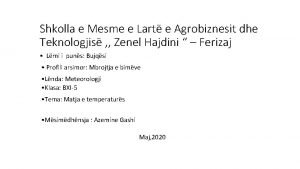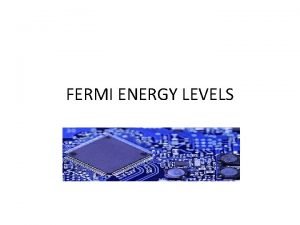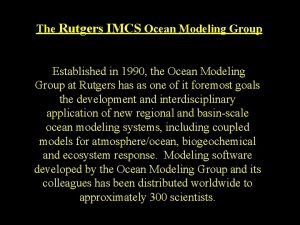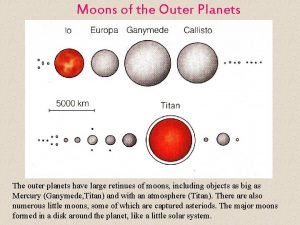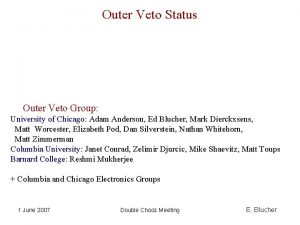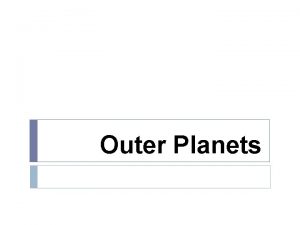Outer Tracker Preheater Temperatures Tom French CERN 29092020












- Slides: 12

Outer Tracker: Preheater Temperatures Tom French (CERN) 29/09/2020

Observed Effects & Rationale for Pre-Heaters • Liquid CO 2 can arrive at the detector sub-cooled through coaxial pipes, to bring it up to the saturation temperature, we need to inject heat. CO 2 Set Point -24. 5 °C Dummy Load Power 324 W Pre-Heater Power 0 W Flow Rate 1. 3 g/s Sub-cooled CO 2 liquid over first 1 -2 modules with temperature rise of 3°C, then boiling starts and temperature drops due to pressure drop in pipe. • When it reaches the saturation point, the liquid CO 2 may not start to boil immediately, it can become superheated if heated gently (e. g. by modules or environmental heat leak). We need to apply a “kick” to trigger boiling. 20/06/2019 +13°C superheat CO 2 Set Point -24. 5 °C Dummy Load Power 324 W Pre-Heater Power 0 W Flow Rate 1. 3 g/s Superheating visible on dummy load start-up at -24°C with no pre-heater. Temperature rises by 15°C before suddenly dropping back to the 2 -phase curve seen above. T. French - G. Baldinelli – F. Bianchi 22

Preheater Operation Preheater Test Results – Temperature Plots Principle of operation: • A small heater creates a high heat flux on the tube wall and generates bubbles. This disturbs any superheating downstream of the heater and provides stable temperatures for the detector electronics. Baseline operation: 1. The CO 2 flow is started. 2. The preheater is turned on to prevent superheating. 3. The modules are turned on. • If needed, the preheater can be turned off, or off then on again after the modules are on. • Benefit: can check preheater temperature to see if cooling is working before switching on modules. Alternative operation: 1. The CO 2 flow is started. 2. The modules are turned on. 3. The preheater is turned on to remove any superheating which is present. 3

Example TB 2 S Pipework Return manifold OUTLET TB 2 S Ladder Evaporator tube 2 or 3 ladders in series TB 2 S Ladder INLET Evaporator tube Inlet capillary Preheater outside ladder Inlet manifold Alternative preheater position inside the ladder (Mikko Barinoff) 4 kamil. cichy@cern. ch, thomas. french@cern. ch

Example TBPS Tilted Pipework Return manifold OUTLET TBPS Layer TBPS Ring Preheater on ring tube Inlet capillary Detector flange INLET Evaporator tube Inlet Manifold 5

Temperatures • A temperature sensor on the preheater would give the following readings: Preheater off, cooling off Shows pipe temperature Preheater off, cooling on Shows CO 2 temperature Preheater on, cooling on Check cooling is on before turning modules on Preheater on, cooling off Preheater overheats rapidly (2°C/s) • Therefore, a temperature reading should be present to prevent overheating of the resistors. If they overheat (to about 180°C) the casing melts and the resistance tends to open circuit. • 1 temperature reading is needed per preheater, with which an interlock would turn off both resistors in the case of overheating. There is one preheater (each with 2 resistors) per evaporator section (e. g. 3 ladders in series). • 2 temperature sensors could be used for redundancy. 6

Flow Stop 7


Monitoring CO 2 • Perhaps a useful place to put a temperature sensor if we wanted to monitor the CO 2 would be as shown in the plot below. • On the pipe, >10 mm away from a heat source, to give CO 2 fluid temperature. • A sensor here, combined with a general return manifold T reading, would show the delta T (therefore pressure drop) in each evaporator. • This sensor would also show if large amounts of superheating were happening. Possible sensor position 9

Test Setup: TB 2 S Ladders • Using existing Tracker Outer Barrel rods with the right size cooling pipes (2. 0 x 2. 2 mm made out of Copper-Nickel), installed in an insulated box in the cold room in CERN building 186. The cold room is set to the CO 2 saturation temperature (down to -25°C) to give an essentially adiabatic test environment (room temperature tuned to give no change in liquid CO 2 temperature through the setup). • Modules represented by 72 x 200Ω dummy load resistors providing 2 W nominal (4 W max) per cooling point, controlled by a power supply. • TRACI CO 2 plant used (can achieve ≈ -25°C with 150 W load). • Pre-heater mounted on pipe before 1 st ladder inlet and controlled with a separate power supply. • Temperature distribution mapped using PT 100 RTDs. CO 2 Out 20/06/2019 T. French - G. Baldinelli – F. Bianchi CO 2 In 8 mm pre-heater concept tested (2 x 10Ω resistors clamped to pipe) 10

Preheater Operation – Summary 9: 08 Preheater on with 10 W. Flow was 2. 62 g/s. I left it with just the preheater on for just under 2 hours to see if there were any strange effects, none seen. 11: 13 Module power on with 234 W for 3 ladders. Due to increased resistance, the flow decreased from 2. 62 g/s to 2. 35 g/s. The temperature increase in the preheater is due to this drop in flow rate. 11: 27 Preheater turned off. Cooling insert temperature drops in the first few cooling inserts by about 2°C. 12: 08 Module power off. • Note that there is no superheating in this plot (due to the preheater being on). Without the preheater (or with too small power in the preheater), there is about 4°C of superheating of the fluid, and poorer HTC in the first few cooling inserts. 11

Preheater on BEFORE modules • Transition observed in insert temperature at 5. 9 W for this particular example. Superheating gone! 12
 Sap preheater
Sap preheater Alstom wellsville ny
Alstom wellsville ny Air preheater diagram
Air preheater diagram Tom tom go 910
Tom tom go 910 Symbols in the devil and tom walker
Symbols in the devil and tom walker Law of intermediate temperatures
Law of intermediate temperatures Classification of chordata
Classification of chordata Instrumenti per matjen e temperatures se ajrit
Instrumenti per matjen e temperatures se ajrit Fermi-dirac distribution function at different temperatures
Fermi-dirac distribution function at different temperatures Canada heat wave temperatures
Canada heat wave temperatures Fermi energy formula
Fermi energy formula Rutgers ocean temperatures
Rutgers ocean temperatures What is the definition of sanitizing servsafe
What is the definition of sanitizing servsafe







